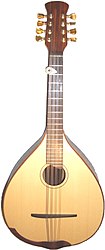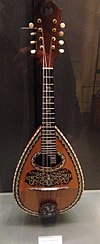The banjo is a stringed instrument with a thin membrane stretched over a frame or cavity to form a resonator. The membrane is typically circular, and usually made of plastic, or occasionally animal skin. Early forms of the instrument were fashioned by African Americans in the United States. The banjo is frequently associated with folk, bluegrass and country music, and has also been used in some rock, pop and hip-hop. Several rock bands, such as the Eagles, Led Zeppelin, and the Grateful Dead, have used the five-string banjo in some of their songs. Historically, the banjo occupied a central place in Black American traditional music and the folk culture of rural whites before entering the mainstream via the minstrel shows of the 19th century. Along with the fiddle, the banjo is a mainstay of American styles of music, such as bluegrass and old-time music. It is also very frequently used in Dixieland jazz, as well as in Caribbean genres like biguine, calypso and mento.

The guitar is a fretted musical instrument that typically has six strings. It is usually held flat against the player's body and played by strumming or plucking the strings with the dominant hand, while simultaneously pressing selected strings against frets with the fingers of the opposite hand. A plectrum or individual finger picks may also be used to strike the strings. The sound of the guitar is projected either acoustically, by means of a resonant chamber on the instrument, or amplified by an electronic pickup and an amplifier.

A mandolin is a stringed musical instrument in the lute family and is generally plucked with a pick. It most commonly has four courses of doubled metal strings tuned in unison, thus giving a total of 8 strings, although five and six course versions also exist. The courses are typically tuned in an interval of perfect fifths, with the same tuning as a violin. Also, like the violin, it is the soprano member of a family that includes the mandola, octave mandolin, mandocello and mandobass.

String instruments, stringed instruments, or chordophones are musical instruments that produce sound from vibrating strings when a performer plays or sounds the strings in some manner.

The bouzouki, also spelled buzuki or buzuci, is a musical instrument popular in Greece. It is a member of the long-necked lute family, with a round body with a flat top and a long neck with a fretted fingerboard. It has steel strings and is played with a plectrum producing a sharp metallic sound, reminiscent of a mandolin but pitched lower. There are two main types of bouzouki: the trichordo (three-course) has three pairs of strings and the tetrachordo (four-course) has four pairs of strings. The instrument was brought to Greece in the early 1900s by Greek refugees from Anatolia, and quickly became the central instrument to the rebetiko genre and its music branches. It is now an important element of modern Laïko pop Greek music.

A twelve-string guitar is a steel-string guitar with 12 strings in six courses, which produces a thicker, more ringing tone than a standard six-string guitar. Typically, the strings of the lower four courses are tuned in octaves, with those of the upper two courses tuned in unison. The gap between the strings within each dual-string course is narrow, and the strings of each course are fretted and plucked as a single unit. The neck is wider, to accommodate the extra strings, and is similar to the width of a classical guitar neck. The sound, particularly on acoustic instruments, is fuller and more harmonically resonant than six-string instruments. The 12-string guitar can be played like a 6-string guitar as players still use the same notes, chords and guitar techniques like a standard 6-string guitar, but advanced techniques might be tough as players need to play or pluck two strings simultaneously.
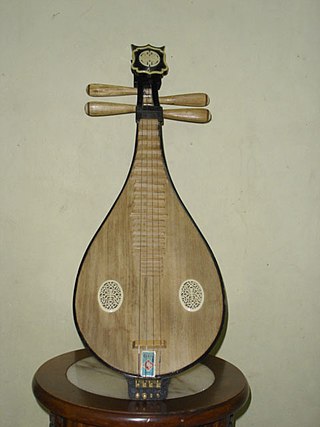
The liuqin is a three, four or five -stringed Chinese mandolin with a pear-shaped body. The range of its voice is much higher than the pipa, and it has its own special place in Chinese music, whether in orchestral music or in solo pieces. This has been the result of a modernization in its usage in recent years, leading to a gradual elevation in status of the liuqin from an accompaniment instrument in folk Chinese opera, to an instrument well-appreciated for its unique tonal and acoustic qualities. The position of the instrument is lower than the pipa, being held diagonally like the Chinese ruan and yueqin. Like the ruan and unlike the pipa its strings are elevated by a bridge and the soundboard has two prominent soundholes. Finally, the instrument is played with a pick with similar technique to both ruan and yueqin, whereas the pipa is played with the fingers. Therefore, the liuqin is most commonly played and doubled by those with ruan and yueqin experience.
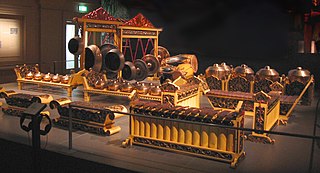
A folk instrument is a musical instrument that developed among common people and usually does not have a known inventor. It can be made from wood, metal or other material. Such an instrument is played in performances of folk music.

The mandocello is a plucked string instrument of the mandolin family. It is larger than the mandolin, and is the baritone instrument of the mandolin family. Its eight strings are in four paired courses, with the strings in each course tuned in unison. Overall tuning of the courses is in fifths like a mandolin, but beginning on bass C (C2). It can be described as being to the mandolin what the cello is to the violin.

The Irish bouzouki is an adaptation of the Greek bouzouki. The newer Greek tetrachordo bouzouki was introduced into Irish traditional music in the mid-1960s by Johnny Moynihan of the folk group Sweeney's Men. Alec Finn, first in the Cana Band and subsequently in De Dannan, introduced the first Greek trichordo (3 course) bouzouki into Irish music.
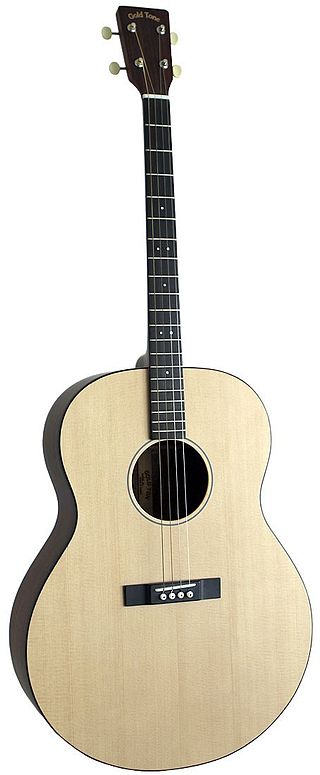
The tenor guitar or four-string guitar is a slightly smaller, four-string relative of the steel-string acoustic guitar or electric guitar. The instrument was initially developed in its acoustic form by Gibson and C.F. Martin so that players of the four-string tenor banjo could double on guitar.

The octave mandolin or octave mandola is a fretted string instrument with four pairs of strings tuned in fifths, G−D−A−E, an octave below a mandolin. It is larger than the mandola, but smaller than the mandocello and its construction is similar to other instruments in the mandolin family. Usually the courses are all unison pairs but the lower two may sometimes be strung as octave pairs with the higher-pitched octave string on top so that it is hit before the thicker lower-pitched string. Alternate tunings of G−D−A−D and A−D−A−D are often employed by Celtic musicians.
The cuatro is a family of Latin American string instruments played in Puerto Rico, Venezuela and other Latin American countries. It is derived from the Spanish guitar. Although some have viola-like shapes, most cuatros resemble a small to mid-sized classical guitar. In Puerto Rico and Venezuela, the cuatro is an ensemble instrument for secular and religious music, and is played at parties and traditional gatherings.
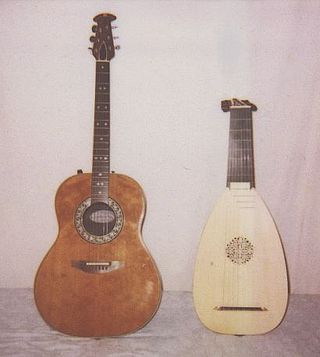
Plucked string instruments are a subcategory of string instruments that are played by plucking the strings. Plucking is a way of pulling and releasing the string in such a way as to give it an impulse that causes the string to vibrate. Plucking can be done with either a finger or a plectrum.

Mandobass is the largest member of the mandolin family, sometimes used as the bass instrument in mandolin orchestras. It is so large that it usually is not held in the lap, but supported on a spike that rests on the floor. The neck-scale length on a full-size mando-bass is similar to that of a standard orchestral double bass viol: about 43 inches (110 cm). The instrument is otherwise similar to the smaller, higher-pitched members of the mandolin family, having a fretted neck, a headstock with geared tuning machines, and a large resonating body often—but not always—shaped like that of other mandolins.
The octophone is a stringed musical instrument related to the mandola family resembling an octave mandolin. It was marketed by Regal Musical Instrument Company, who introduced it 21 January 1928, as an "eight-purpose instrument".

The Algerian mandole is a steel-string fretted instrument resembling an elongated mandolin, widely used in Algerian music such as Chaabi, Kabyle music and Nuubaat.

The tambura is a stringed instrument that is played as a folk instrument in Bosnia and Herzegovina, Bulgaria, Croatia, North Macedonia, and Serbia. It has doubled steel strings and is played with a plectrum, in the same manner as a mandolin.

A mandolone is a member of the mandolin family, created in the 18th century. It is a bass range version of the Neapolitan mandolin. Its range was not as good as the mandocello, which replaced it in mandolin orchestras, and had largely disappeared in the 19th century.
